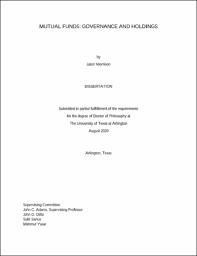
ATTENTION: The works hosted here are being migrated to a new repository that will consolidate resources, improve discoverability, and better show UTA's research impact on the global community. We will update authors as the migration progresses. Please see MavMatrix for more information.
Show simple item record
| dc.contributor.advisor | Adams, John C | |
| dc.creator | Morrison, Jason | |
| dc.date.accessioned | 2020-09-10T17:38:24Z | |
| dc.date.available | 2020-09-10T17:38:24Z | |
| dc.date.created | 2020-08 | |
| dc.date.issued | 2020-09-02 | |
| dc.date.submitted | August 2020 | |
| dc.identifier.uri | http://hdl.handle.net/10106/29414 | |
| dc.description.abstract | In this dissertation I examine the role of governance and holdings within the mutual funds industry to determine if active managed fund strategies are affecting fund flows and increasing returns. My first two essays focus on dividend juicing and the results of this strategy and the types of boards of directors that would allow this strategy to be implemented. My third essay focuses on the concentration of holdings and the effect on the overall fund performance. I use hand collected data on the governance characteristics of the board of directors as well as the economic data and holdings of the funds themselves to assist in my calculations.In the first essay, I examine incidences of dividend juicing among mutual funds.Dividend juicing is the method by which mutual fund managers realize additional dividends for their shareholders by manipulating holdings. Harris, Hartzmark, and Solomon (2015) find evidence that juicing is associated with higher turnover, increased taxes and lower returns. They conclude dividend juicing is costly and is employed to exploit unsophisticated investor demand for higher dividends. I reexamine this issue utilizing a more rigorously defined data set and with a more robust methodology and find that, contrary to the existing literature, dividend juicing is associated with higher returns and positive outcomes for the shareholder, and this is most evident in funds with a dividend yield higher than 0.5%. In the second essay, I provide new evidence to suggest that a higher incidence of mutual fund board of director independence helps to create an environment conducive to actively employing dividend juicing tactics in off-reporting periods to increase dividend yields, higher returns, and lower expenses. Coupled with the lower turnover rate, this helps to establish that independence of the board helps to generate investors by enticing them with higher dividend payouts. Overall, the results are consistent with this being a good strategy for those funds that attempt it.In the third essay, I study mutual funds and the puzzle of diversification and active trading strategies among fund managers. I utilize multiple economic factors, a well matched and fully clean sample set by using the Pastor, Stambaugh and Taylor (2013) methodology to ensure the highest level of accuracy and attempt to show economic reasoning for funds that choose to be actively non-diversified, rather than fully diversified. At this time, there is no economic evidence to suggest a valid reason not to move away from idiosyncratic risk and open investors up to the damage a non-diversified portfolio could incur. | |
| dc.format.mimetype | application/pdf | |
| dc.language.iso | en_US | |
| dc.subject | Mutual Funds | |
| dc.subject | Governance | |
| dc.subject | Holdings | |
| dc.title | Mutual Funds: Governance and Holdings | |
| dc.type | Thesis | |
| dc.degree.department | Finance | |
| dc.degree.name | Doctor of Philosophy in Finance | |
| dc.date.updated | 2020-09-10T17:38:25Z | |
| thesis.degree.department | Finance | |
| thesis.degree.grantor | The University of Texas at Arlington | |
| thesis.degree.level | Doctoral | |
| thesis.degree.name | Doctor of Philosophy in Finance | |
| dc.type.material | text | |
| dc.creator.orcid | 0000-0003-4703-6193 | |
Files in this item
- Name:
- MORRISON-DISSERTATION-2020.pdf
- Size:
- 1.084Mb
- Format:
- PDF
This item appears in the following Collection(s)
Show simple item record


